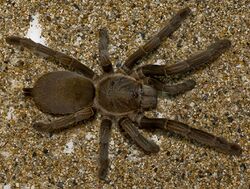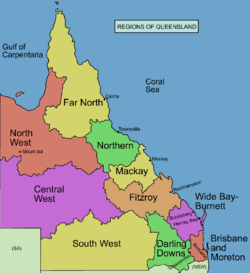Biology:Selenocosmia crassipes
| Queensland whistling tarantula | |
|---|---|

| |
| Scientific classification | |
| Domain: | Eukaryota |
| Kingdom: | Animalia |
| Phylum: | Arthropoda |
| Subphylum: | Chelicerata |
| Class: | Arachnida |
| Order: | Araneae |
| Infraorder: | Mygalomorphae |
| Family: | Theraphosidae |
| Genus: | Selenocosmia |
| Species: | S. crassipes
|
| Binomial name | |
| Selenocosmia crassipes (L. Koch, 1874)
| |

| |
| Synonyms[1] | |
| |
Selenocosmia crassipes, synonym Phlogius crassipes, also known as the "Queensland whistling tarantula", "barking spider" or "bird-eating tarantula" is a species of tarantula native to the east coast of Queensland, Australia. The name "whistling tarantula" comes from its ability to produce a hissing noise when provoked, a trait it shares with other Australian theraphosids.[2] This hissing is produced by the spider stridulating a patch of setae associated with its chelicerae. It has also been called the "eastern tarantula".[3] The species name crassipes is Latin for "fat leg" referring to the relatively fat front legs.
Selenocosmia crassipes can attain legspans of up to 22 cm (8.7 in). Its body length, from eyes to the rear of its abdomen, measures between 6 and 9 cm (2.4 and 3.5 in), making it the largest Australian tarantula.
Description
Venom
The bite from an Eastern tarantula is not fatal to a human, but can cause up to six hours of vomiting. The venom can cause death to a dog or cat within thirty minutes.[3][4]
In May 2010 a scientist living near Cooktown, Queensland, was bitten on her right index finger and experienced symptoms never reported before in research literature. The finger became swollen and very sensitive to touch within one hour. "The pain was so intense that sleep that night was impossible. Fifteen hours post-bite, the adjoining finger and upper hand were also swollen and painful." The pain and swelling were limited to the hand and lower arm only (and not systemic as previously reported) and she reported that they had both eased after 26 hours. Photos were taken at various stages of the swelling.[5]
Diet
Despite the sometimes used common names bird-eating spider and bird spider, this nocturnal ground dwelling species is not likely to ever encounter or feed on birds. These spiders predominantly feed upon invertebrates including insects and other spiders. Small vertebrates such as geckos, skinks and frogs are also part of the diet.[citation needed]
Taxonomy
Selenocosmia crassipes was first described by Ludwig Koch in 1874,[6] as Phrictus crassipes. It was subsequently transferred to the genus Phlogius by Simon in 1887 as the genus name Phrictus was already applied to a group of lanternflies.[7] However Simon did not change the diagnosis or description, just gave the species a unique genus name. In 1895, Pocock did not show a way to differentiate Phlogius and Selenocosmia, then in 1900, Pocock labelled Phlogius as a synonym of Selenocosmia. In 1982, the Australian arachnologist Barbara York Main recognised the Australian taxa as Selenocosmia. In 1995, Günter Schmidt transferred the species back to the genus Phlogius,[8] however the transfer of the Australian fauna from Selenocosmia to Phlogius was rejected by Raven 2000, argued that Schmidt had not compared the holotype specimens of both genera.[9] Therefore the World Spider Catalog only recognises Phlogius as a junior synonym. As all previous taxonomic revisions of this group have been based on morphology only, molecular data will likely be required to settle this debate.[6]
Distribution and habitat
As a pet
Selenocosmia crassipes is a fast-growing spider and widely sought after as a pet. It is harvested from the wild, often illegally, which is a threat to its natural population.[10]
References
- ↑ "Taxon details Selenocosmia crassipes (L. Koch, 1874)", World Spider Catalog (Natural History Museum Bern), http://www.wsc.nmbe.ch/species/37878, retrieved 2018-06-01
- ↑ "Tarantula or Whistling Spiders". Queensland Museum. http://www.qm.qld.gov.au/Find+out+about/Animals+of+Queensland/Spiders/Primitive+Spiders+Infraorder+Mygalomorphae/Tarantula+or+Whistling+Spiders. Retrieved 23 March 2014.
- ↑ 3.0 3.1 Townsville Bulletin: Spider invasion in Bowen
- ↑ Queensland Museum (2000), p. 40.
- ↑ Raven and Covacevich (2012), pp. 19-22.
- ↑ 6.0 6.1 Koch, L (1874). Die Arachniden Australiens, nach der Natur beschrieben und abgebildet. Nürnberg: Bauer & Raspe. pp. 473-576.
- ↑ Simon, E. "Observation sur divers arachnides: synonymies et descriptions.". Annales de la Société Entomologique de France 6 (7).
- ↑ Schmidt, G. "Gehören "Selenocosmia" crassipes (L. Koch, 1873) und "Selenocosmia" stirlingi Hogg, 1901 (Araneida: Theraphosidae: Selenocosmiinae) wirklich zu Selenocosmia Ausserer, 1871?.". Arachnologisches Magazin 3 (11): 1-12.
- ↑ Raven, Robert. "Taxonomica Araneae I: Barychelidae, Theraphosidae, Nemesiidae and Dipluridae (Araneae).". Memoirs of the Queensland Museum 45: 569-575.
- ↑ "Tarantulas" (in en-AU). 2019-01-22. https://environment.des.qld.gov.au/wildlife/animals/living-with/tarantulas.
External links
Wikidata ☰ Q1306747 entry
 |

